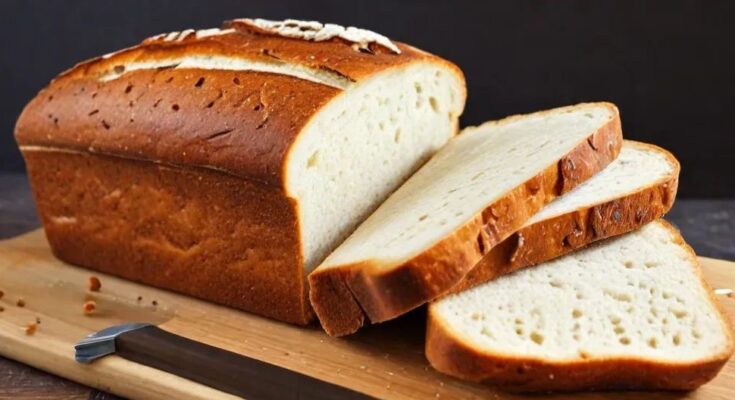The Story Behind the Bread:
It was a Saturday morning, and the smell of tasty, smooth freshly baked bread covered the whole house. The perfect gluten free sourdough bread loaf was sitting on the counter, still warm, with a crust that crackled when touched. The family gathered, ready for breakfast, but this time, something was different—no one had to ask, “Is this gluten-free?”
That’s because I’d perfected the gluten free sourdough bread recipe, something I had struggled with for months. And now, the journey begins. Whether you are gluten-sensitive, celiac, or just love experimenting with different kinds of bread, this recipe will have you hooked. Even better, it’s quick and easy—no need for day-long fermentations or complicated steps. In just 30 minutes, the fresh loaf is ready to go.
“Explore our easy-to-follow recipe for 15 Delicious Gluten-Free Recipes You Must Try for a Healthier Lifestyle that are sure to satisfy your sweet tooth!”
But before we dive in, let’s explore what makes this recipe special and why gluten-free sourdough can be a game-changer in your baking routine.
Why Gluten Free Sourdough Bread is a Unique product?
Sourdough bread is known for its strong and sharp smell, it is not easily chewed, and it includes a long fermentation process, meaning its flavor development will take some time to develop. Yeast works as a mixture of flour and water to create it, left to ferment over time. For gluten free sourdough bread, things get a little tricky because gluten provides the stretch and structure that gives bread its airy, chewy nature. That’s where gluten-free flours and alternative ingredients come in to save the day.
Interestingly, gluten free sourdough bread isn’t just for those avoiding gluten. Studies suggest that sourdough’s fermentation process breaks down many of the proteins that cause digestive discomfort, making it easier on the stomach compared to regular bread. According to research published in the Journal of Cereal Science, the fermentation process reduces gluten content and can even aid in digestion for some gluten-sensitive individuals.
“Enjoy a fluffy stack of 8 Delightful Gluten Free Cakes You’ll Love that are quick to whip up and perfect for lazy weekend mornings.”
Ingredients You’ll Need:
For a quick 30-minute gluten-free sourdough recipe, you’ll need a few key ingredients. Don’t worry—nothing too complicated!
The Sourdough Starter:
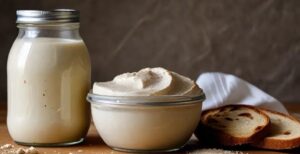
- Gluten-free flour blend (rice flour, sorghum flour, or a mix) – 1 cup
- Water – 1 cup (filtered water is ideal)
- A pinch of salt
Note: You can make your own gluten free sourdough bread starter in just 5-7 days. Mix equal quantity of gluten-free flour and water in a jar. To make it better daily add more flour and water in it. When it’s bubbly and smells slightly sour, it’s ready!
For the Bread:
- Gluten-free flour blend – 3 cups
- Sourdough starter – 1 cup
- Psyllium husk powder – 1 tablespoon (helps with the elasticity)
- Baking soda – 1 teaspoon (for extra rise)
- Apple cider vinegar – 1 teaspoon (activates the soda)
- Warm water – 1 ½ cups
- Olive oil – 2 tablespoons (optional, for a softer crust)
- Salt – 1 teaspoon
“Try our delightful 8 Easy Steps to the Perfect Gluten Free Biscuit Recipe in Just 30 Minutes recipe, which is perfect for a quick breakfast on the go!”
The 30-Minute Gluten Free Sourdough Bread Recipe
If you’re like me, you don’t always have hours to let gluten free sourdough bread rise or ferment. Luckily, this quick recipe bypasses the lengthy fermentation times by leveraging a well-fed sourdough starter and baking soda for a rapid rise. This recipe gets ready on time without disturbing its flavor or texture.
By using this method, you can enjoy your gluten free sourdough bread without sacrificing taste or texture; while still cutting down on the time it takes to make traditional sourdough.
Step 1: Prepare the Dough (10 minutes)

1- Mix Dry Ingredients: In a large bowl, whisk together the gluten-free flour blend, psyllium husk, salt, and baking soda.
2- Activate the Ingredients: Add the apple cider vinegar to warm water, then pour this mixture into the dry ingredients.
Step 2: Shape and Rest (5 minutes)
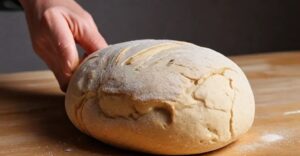
- Shape the Dough: Turn the dough onto a lightly floured surface (gluten-free flour, of course) and shape it into a round loaf or place it into a loaf pan.
- Let it Rest: While traditional sourdough would rest for hours, give this dough 5 minutes to settle and hydrate the flour.
Step 3: Bake to Perfection (15-20 minutes)
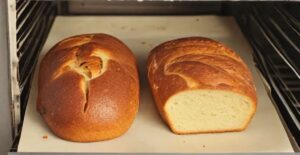
- Preheat the Oven: Heat your oven to 425°F (220°C).
- Bake: Put the loaf in the oven and bake 15-20 minutes, until the crust gets golden brown and the gluten free sourdough bread tests ‘hollow.’ A quick check with a thermometer should show the internal temperature around 200°F (93°C).
“Discover how to make your own 5 Irresistible Gluten Free Desserts You’ll Love from scratch with our simple and delicious recipe!
Why This Recipe Works: The Science Behind It
This recipe leverages the power of psyllium husk to replace the gluten that regular gluten free sourdough bread relies on. In fact, psyllium absorbs water and forms a gelatinous substance that gives the dough a structure comparable to gluten. It will work like a nutritional booster in your bread.
Another secret ingredient is apple cider vinegar. By combining it with baking soda, you create a rapid rise effect, helping your gluten free sourdough bread achieve that signature fluffy texture in a fraction of the time.
According to a study published by the American Journal of Clinical Nutrition, incorporating fermented foods like sourdough into your diet can improve gut health due to the presence of beneficial bacteria and lower levels of FODMAPs, which are responsible for digestive discomfort in some people. So, not only is this gluten-free sourdough bread quick and easy to make, but it’s also potentially beneficial for your digestion.
Variations to Spice It Up
You don’t have to stop with the classic recipe! Creativity has no limit. There are lots of ways to get creative with your gluten-free sourdough bread.
1. Herbed Sourdough
Add chopped rosemary, thyme, or basil to your dough for a fragrant, savory twist. It is best to use as a side for soups and salads.

2. Seeded Sourdough
If you want to get more flavor and texture just mix it with sunflowers seeds. These seeds will also give your bread a rustic look.

3. Cheesy Sourdough
Grate in a cup of your favorite dairy-free cheese (or regular cheese if you’re not avoiding dairy). This will melt into the dough, adding a rich flavor with every bite.

4. Sweet Cinnamon Raisin Sourdough
For a breakfast treat, try adding a teaspoon of cinnamon and a handful of raisins or dried cranberries. This pairs beautifully with a spread of butter or jam.
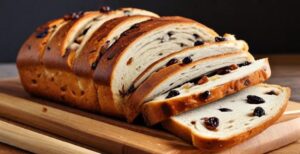
Tips for Gluten-Free Bread Success
- Keep Your Starter Happy: Regularly feed your gluten-free starter with fresh flour and water. To keep the product same, it should be stored in a Fridge.
- Don’t Skip the Psyllium Husk: This ingredient is important for binding force in the dough. Without it, your bread could break.
- Measure by Weight, Not Volume: Gluten-free flours vary in density, so using a kitchen scale can lead to better, more consistent results.
- Use a Preheated Dutch Oven: If you have one, baking your bread in a preheated Dutch oven will help create steam and develop that perfect crust.
Conclusion:
Gluten Free Sourdough Bread Doesn’t Have to Be Hard
Making gluten free sourdough bread at home can seem like a daunting task, but with the right ingredients and a bit of patience, it’s totally doable—and fast! By focusing on psyllium husk for structure and using your sourdough starter, you can enjoy fresh, homemade bread in under 30 minutes. Due to endless variations, you can do lots of experiments with the flavor and taste.
“Satisfy your cravings with our rich and fudgy 5 Irresistible Gluten Free Desserts You’ll Love that make for a perfect dessert!”
So, are you ready to whip up your next gluten-free sourdough loaf? What variations will you try first?

